New homes for 32 Waimanalo homeless not allowed, state says

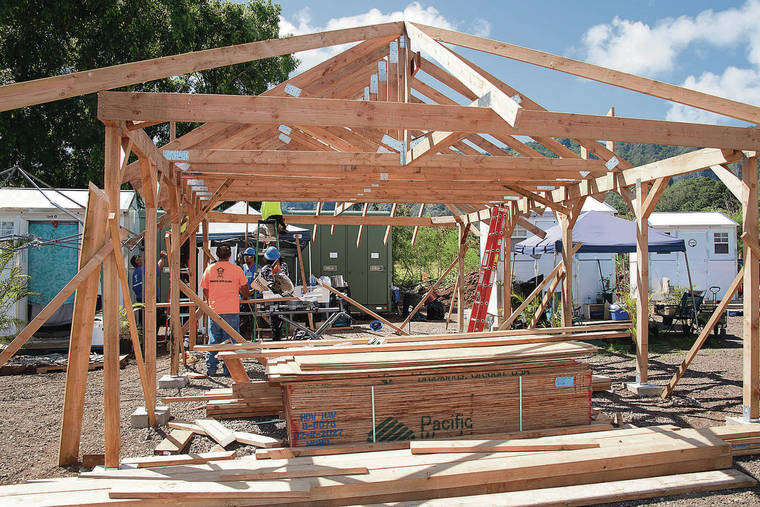
CRAIG T. KOJIMA /CKOJIMA@STARADVERTISER.COM
Volunteers build a new house for the homeless in Waimanalo. About 100 more are planned off the road on Hilu Street in Waimanalo.
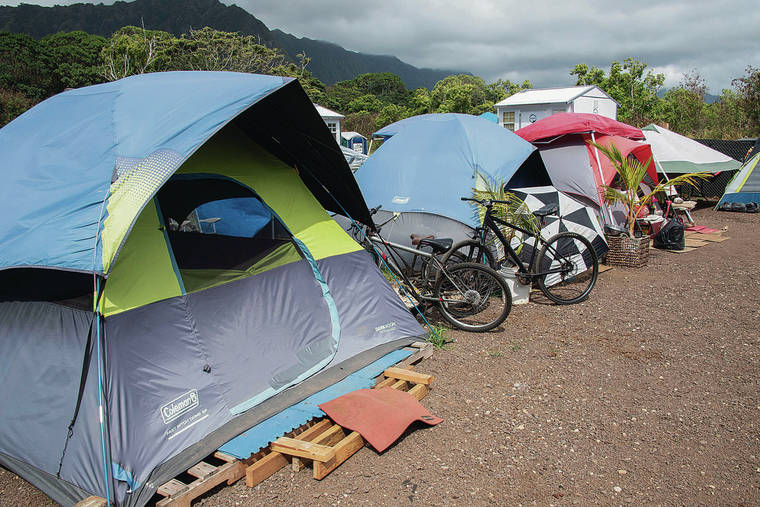
CRAIG T. KOJIMA /CKOJIMA@STARADVERTISER.COM
Tents are lined up in Waimanalo, where Blanche McMillan plans to erect homes.
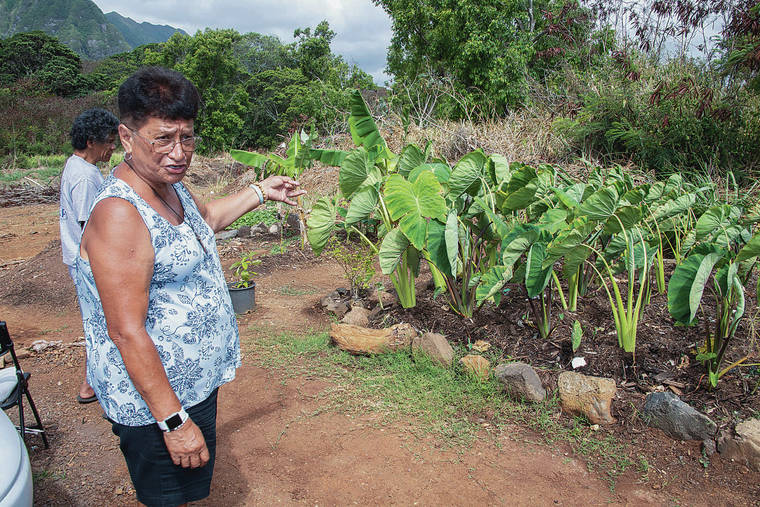
CRAIG T. KOJIMA /CKOJIMA@STARADVERTISER.COM
Blanche McMillan points to a garden that the encampment members planted themselves. McMillan plans to build 100 more homes on state land. The state, meanwhile, says those plans were never allowed.
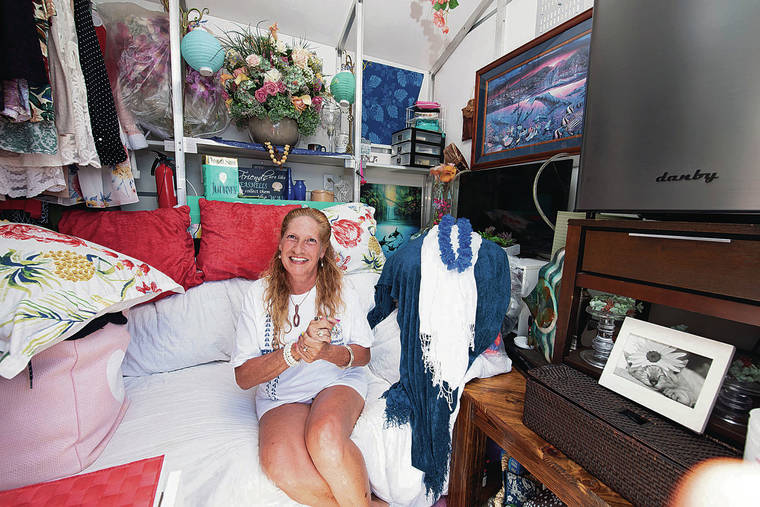
CRAIG T. KOJIMA /CKOJIMA@STARADVERTISER.COM
Pamela Rundgren were one of the first to arrive at the site. She had been living separately at Waimanalo Beach Park. They helped clear the land and set up their individual 8-by-8-foot fiberglass homes. The area was “nothing but dirt,” Rundgren said. “But we put on our doors and screwed everything together.”
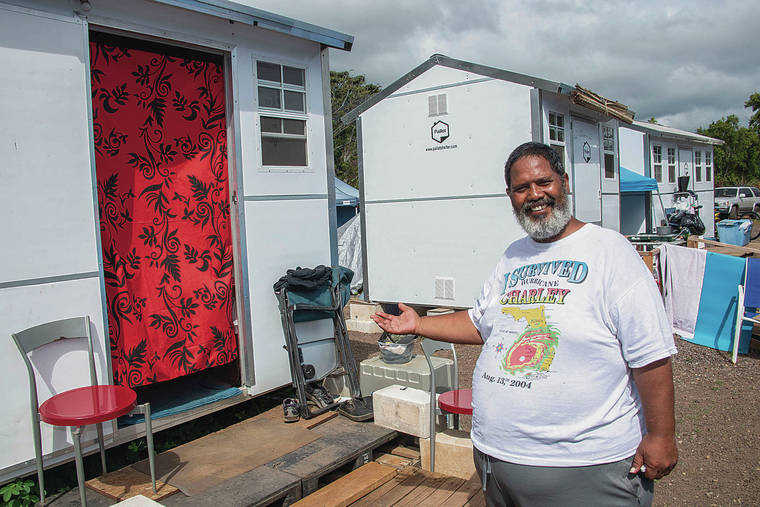
CRAIG T. KOJIMA /CKOJIMA@STARADVERTISER.COM
Jadfree Purdy of Waimanalo spent about five months on the beach before being given a place to stay.






In just three months, “Auntie Blanche” McMillan has created permanent homes for 32 homeless people from Waiminalo and plans to build 100 more on state land at the end of the road on Hilu Street.
McMillan’s vision called “Hui Mahi‘ai Aina” — or, loosely, the land of group farming — originally was part of Lt. Gov. Josh Green’s plan for a statewide system of “kauhale” tiny homes to provide permanent housing for Hawaii’s homeless.
But troubles lie ahead.
In a statement, Suzanne Case, chairwoman of the state Department of Land and Natural Resources, told the Honolulu Star-Advertiser that McMillan’s ambitious plans were never allowed.
>> PHOTOS: State says new homes for 32 Waimanalo homeless not allowed Opens in a new tab
“Blanche McMillan has no land disposition for the project on this land, nor did she request or receive authorization to build the kauhale structures,” Case said in an email. “Her original right of entry, which has expired, was for due diligence for community farming, not for housing. The parcel is in a flood zone that has acted as a water holding basin in the past. These land issues need to be resolved moving forward.”
Don't miss out on what's happening!
Stay in touch with breaking news, as it happens, conveniently in your email inbox. It's FREE!
Even as $20 million in proposed state funding for a kauhale pilot project dried up in the legislature earlier this year, McMillan pushed on and used her original right of entry to create permanent housing on half of 15 acres of DLNR land directly behind her home on Hawaiian Homestead Land where she grew up, one of nine sisters and eight brothers, and where she still lives.
McMillan, a fixture in Waima-nalo and a former neighborhood board member, has been helping homeless people in her community for years by organizing food distributions and other assistance.
But in late March McMillan stepped up her game.
She went down to the beach park occupied by more than 350 homeless people in and around Kalanianaole Highway and announced that anyone was welcome to follow her to DLNR’s mauka lands off of Hilu Street.
“I said, ‘You guys are coming home now,’” McMillan remembered. “‘It’s time to come home.’”
But the original 34 people who followed McMillan had to work for it. Acres of brush had to be cleared, along with abandoned vehicles, other junk and an “ice box.”
And there were rules to follow, such as no drugs, no violence and a requirement that everyone take turns providing security.
All visitors have to leave by 7 p.m., the entry gate is locked at 9 p.m. and everyone has to abide by a 10 p.m. curfew.
Every person also has to pay $100 per month — often through government benefits — to help support utilities, including two outdoor showers heated by propane, solar-powered electricity and maintenance on six portable toilets. McMillan is also working with the city to connect a water line.
Two of the original homeless people who followed McMillan from the beach could not fit in and left.
Even some who remain, such as Constance “Connie” Oki, 72, admitted that she can sometimes “be difficult,” as she and her new neighbors laughed at her tendency toward obstinance.
“We have to be part of a team,” Oki said. “I was not anticipating that.”
McMillan already has recruited five Windward churches for support and to help feed the residents, who are otherwise responsible for buying their own groceries through government food stamps. Residents now regularly get checked out at the Waimanalo Health Center and get additional help from the Institute for Human Services, among others.
There are also new routines, such as Bible study.
Residents are excited about harvesting their first crops that they’ve been cultivating of dry land taro, sweet potato, papaya, Hawaiian chili pepper, lychee and egg plant. The plan is to use the produce first for themselves to offset food costs — and then expand to growing even more crops for sale to generate revenue.
New residents such as Darryl Kuhia, 49, are happy to pitch in to help keep everything organized.
“It’s not going to work without routine, without structure,” Kuhia said.
The first two to arrive, Pamela Rundgren, 61, and Jadfrey Purdy, 52, remain.
They had been living separately in Waimanalo Beach Park and were the first to move in, help clear the land and set up their individual, 8-by-8-foot fiberglass “Pallet” homes that were provided by “an angel donor” who wishes to remain anonymous.
“It was nothing but dirt,” Rundgren said. “But we put on our doors and screwed everything together.”
Purdy said he chose to follow McMillan out of homelessness because he felt her passion.
“She just hurt for the people,” he said.
Lt. Gov. Green, City Councilman Ikaika Anderson and state Rep. Chris Lee — whose districts include Waimanalo — threw their early support behind McMillan and Hui Mahi‘ai Aina.
The House Finance Committee on Monday passed out an amended version of SB 2206 that authorizes the state Board of Land and Natural Resources — which oversees DLNR — to issue revocable, month-to-month permits for homeless, kauhale-type projects on state land. The effect of the bill would offer potential donors an extra layer of security to projects such as Hui Mahi‘ai Aina while still giving state officials flexibility over projects that run into trouble.
On a different scale, Douglas and Jennifer Vollrath of Makiki continue to arrive with donated clothes, linens and household items and make the drive from Makiki in their Jeep Patriot.
Asked why they don’t donate to those in need closer to home, Jennifer said, “We just have a heart for what Blanche is doing here. It’s just so wonderful.”
Hui Mahi‘ai Aina rapidly expanded over three months into a community composed of a mix of homes: traditional-looking, small houses built by participants of the on-site Youth Build Waimanalo program, which was working to finish a communal kitchen, dining room and laundry area on Tuesday; nine fiberglass tiny “Pallet” homes; and nine temporary tents.
But McMillan has far more ambitious plans. She hopes to find an engineer to volunteer to figure out how to eliminate the land’s flood zone problems, then find someone to donate manpower and heavy equipment to turn the plans into flood-free land, get more earth movers to clear even more land for an expanded agriculture operation that would someday sustain the residents and generate income, and find help and supplies to build a second phase of permanent homes for 100 more people.
Asked when she hoped to get everything finished, McMillan said she’d like to have it all wrapped up by this week.
“First week of July works for me,” she said. “If I don’t do it, who’s gonna do it?”
How to help Hui Mahi‘ai Aina
>> Call “Auntie Blanche” McMillan at 341-5548



